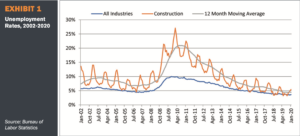Accounting and advisory services firm Marcum LLP, today released its annual analysis of construction employment data from the U.S. Bureau of Labor Statistics’ Job Openings and Turnover Survey (JOLTS). The analysis is produced by Marcum’s national Construction Industry Group to uncover changes and identify emerging trends in construction hiring and jobs availability.
The 2019 Marcum Commercial JOLTS Analysis reports that national construction job openings declined toward the end of 2019 but remain at historically high levels. While job openings across all industries are down on a year-over-year basis for the first time since 2009, the number of open positions remains higher than the number of unemployed Americans.

“The number of available job openings in construction fell from 299,000 at 2019’s onset to 239,000 by the end of the year,” wrote Anirban Basu, author of the report and Marcum’s chief construction economist. “That is remarkable given the fact that homebuilder confidence recently rose to a 20-year high, with single-family building permits surging to close out last year.”
While the number of job openings declined in other private industries as well, construction was one of only four segments sustaining a decline of more than 20 percent in the number of job openings. The number of job openings is falling faster in construction than in the broader economy despite plentiful backlog and a significant amount of spending on public works.
The drop in job openings could be attributed factors such as ongoing economic growth and the reentry of many discouraged workers into the workforce. The nation’s labor force participation rate recently increased to 63.4 percent, with many people who had previously indicated that they were not looking for work returning to the labor market. However, the decline in available positions may be due to increasingly discouraged employers.
“It may be that the number of job openings has slipped because employers, who report growing difficulty finding qualified workers, have given up looking,” wrote Basu. “With the current expansion setting records for durability and unemployment at roughly a 50-year low, it is also possible that employers are discouraged, including in construction.”
The number of construction job openings has declined over the last year but remains near record highs, especially when compared to the levels over the entire economic expansion. Moreover, construction net hires—the difference between the number of people hired and the number of people laid off — has remained low, an indication of a tight labor market.
“The lack of growth in net hires is symptomatic of a tight labor market in which construction firms are competing against one another as well as with employers from other industries for scarce talent,” wrote Basu.
Nonresidential construction firms expect to see sales expand over the next few quarters and will accordingly increase their staffing levels. While there are indications that the demand for new constructions workers has slipped over the past year, the construction labor shortage that has marked the past several years remains firmly in place. As long as this dynamic continues, contractors will increasingly be forced to compete for available workers.









